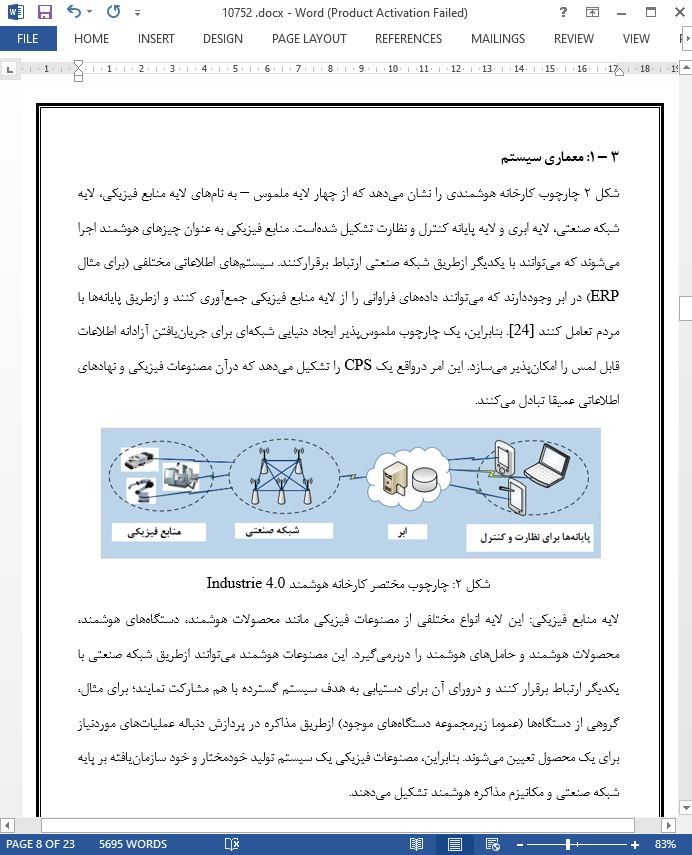
پیاده سازی کارخانه هوشمند صنعتی ۴٫۰
با کاربرد اینترنت اشیاء و سرویس های اینترنتی در ساخت وتولید، مرحله چهارم صنعتی سازی، که به عنوان صنایع 4.0 یاد می شود، درحال وقوع است. برای دستیابی به این حقیقت (Industrie 4.0)، پیاده سازی ادغام افقی شبکه های ارزش بین شرکتی، ادغام انتها به انتهای زنجیره ارزش مهندسی و ادغام عمودی در داخل کارخانه ضروری است. در این مقاله، به منظور پیاده سازی کارخانه هوشمند انعطاف پذیر و قابل پیکربندی، ما بر یکپارچگی افقی تمرکز می کنیم. ابتدا یک چارچوب مختصر را پیشنهاد می کنیم که شبکه های بی سیم صنعتی، شبکه های ابری، و پایانه های ثابت یا متحرک را با مصنوعات هوشمند مانند ماشین ها، محصولات و حامل ها تلفیق می کند. سپس، مکانیزم عملیاتی را از چشم انداز مهندسی کنترل توصیف می کنیم، یعنی، مصنوعات هوشمند حاصل از سیستم خود سازماندهی شده با بازخورد و مجموعه های منطبقی استفاده می شوند که بر روی ابر و براساس داده های تحلیلی بزرگ پیاده سازی شده اند. علاوه برآن، مشخصات فنی مهم و خروجی های سودمند را نیز مطرح می کنیم و یک طرح طراحی دقیق را نیز ارائه می دهیم. سپس نتیجه گیری می کنیم که کارخانه صنعتی هوشمند 4.0 با اعمال گسترده فناوری های موجود ضمن مقابله فعالانه با چالش های فنی قابل دسترس می باشد.
1. مقدمه
اخیرا، فناوری های نوظهور (برای مثال، اینترنت اشیاء (IoT) [1-3]، شبکه های سنسور بی سیم [4, 5]، داده های بزرگ [6]، رایانش ابری [7-9]، سیستم القایی [10]، و اینترنت متحرک [11]) به محیط ساخت وتولید ارائه شده اند، که انقلاب صنعتی چهارم را بوجود آورده اند. متعاقبا، بینش راهبردی که " Industrie 4.0" نامیده می-شود، نیز ارائه و به عنوان بخشی از "طرح اقدام راهبردی فناوری پیشرفته 2020" دولت آلمان پذیرفته شده است. راهبردهای مشابهی نیز در دیگر کشورهای صنعتی – برای مثال، “اینترنت صنعتی” [13] در آمریکا و “اینترنت +” در چین [14] – پیشنهاد شده است. Industrie 4.0 سیستم های فیزیکی سایبری تولیدگرا (CPS) [15 – 17] را توصیف می کند که تسهیلات تولید، سیستم های انبارداری، تدارکات، و حتی الزمات اجتماعی برای ایجاد شبکه های ایجاد ارزش جهانی [18] را یکپارچه می سازد.
6. نتیجه گیری و تحقیقات آینده
با استفاده از فناوری های اطلاعاتی نوظهورر، مانند IoT، داده های بزرگ و رایانش ابری همراه با فناوری های هوش مصنوعی، ما بر این باوریم که کارخانه هوشمند Industrie 4.0 را می توان پیاده سازی کرد. دستگاه های هوشمند و محصولات می توانند با یکدیگر ارتباط و مذاکره داشته باشند و برای تولید انعطاف پذیر چندین نوع محصول به سادگی خود را پیکربندی کنند. داده های عظیم را می توان از مصنوعات هوشمند جمع آوری و ازطریق IWN به ابر منتقل کرد. این امر بازخورد گسترده سیستم و انطباق آن براساس تحلیل داده های بزرگ را جهت بهینه سازی عملکرد سیستم امکان پذیر می سازد. پیکربندی مجدد خود سازمان یافته و بازخورد و انطباق مبتنی بر داده های بزرگ چارچوب و مکانیزم عملیاتی کارخانه هوشمند را تعریف می کند.
With the application of Internet of Things and services to manufacturing, the fourth stage of industrialization, referred to as Industrie 4.0, is believed to be approaching. For Industrie 4.0 to come true, it is essential to implement the horizontal integration of inter-corporation value network, the end-to-end integration of engineering value chain, and the vertical integration of factory inside. In this paper, we focus on the vertical integration to implement flexible and reconfigurable smart factory. We first propose a brief framework that incorporates industrial wireless networks, cloud, and fixed or mobile terminals with smart artifacts such as machines, products, and conveyors.Then, we elaborate the operational mechanism from the perspective of control engineering, that is, the smart artifacts form a self-organized system which is assisted with the feedback and coordination blocks that are implemented on the cloud and based on the big data analytics. In addition, we outline the main technical features and beneficial outcomes and present a detailed design scheme. We conclude that the smart factory of Industrie 4.0 is achievable by extensively applying the existing enabling technologies while actively coping with the technical challenges.
1. Introduction
Recently, the emerging technologies (e.g., Internet of Things (IoT) [1–3], wireless sensor networks [4, 5], big data [6], cloud computing [7–9], embedded system [10], and mobile Internet [11]) are being introduced into the manufacturing environment, which ushers in a fourth industrial revolution. Consequently, a strategic initiative called “Industrie 4.0” was proposed and was adopted as part of the “High-Tech Strategy 2020 Action Plan” of the German government [12]. The similar strategies were also proposed by other main industrial countries, for example, “Industrial Internet” [13] from USA and “Internet +” [14] from China. The Industrie 4.0 describes a production oriented Cyber-Physical Systems (CPS) [15– 17] that integrate production facilities, warehousing systems, logistics, and even social requirements to establish the global value creation networks [18].
6. Conclusions and Future Work
With the emerging information technologies, such as IoT, big data, and cloud computing together with artificial intelligence technologies, we believe the smart factory of Industrie 4.0 can be implemented. The smart machines and products can communicate and negotiate with each other to reconfigure themselves for flexible production of multiple types of products. The massive data can be collected from smart artifacts and transferred to the cloud through the IWN. This enables the system-wide feedback and coordination based on big data analytics to optimize system performance. The above self-organized reconfiguration and big data based feedback and coordination define the framework and operational mechanism of the smart factory.

چکیده
1. مقدمه
2. فلسفه Industrie 4.0
2 – 1: پیش زمینه و هدف
2 – 2: سه نوع ادغام
2 – 3: فناوری های موردنیاز
3. پی ریزی کارخانه هوشمند با IWN و رایانش ابری
3 – 1: معماری سیستم
3 – 2: مکانیزم های عملیاتی
3 – 3: مشخصات فنی
3 – 4: خروجی های سودمند
4. نمایش کاربرد
5. چالش های فنی و راه حل ها
5 – 1: تصمیم گیری هوشمند و مکانیزم مذاکره
5 – 2: پروتکل های IWN با سرعت بالا
5 – 4: مدل سازی و تحلیل سیستم
5 – 5: امنیت سایبری و اموال
5 – 6: مصنوعات فیزیکی انعطاف پذیر و مدول سازی شده
6. نتیجه گیری و تحقیقات آینده
1. Introduction
2. Philosophy of Industrie 4.0
2.1. Background and Purpose.
2.2. Three Kinds of Integration
2.3. Needed Technologies
3. Smart Factory Underpinned by IWN and Cloud
3.1. System Architectur
3.2. Operational Mechanisms.
3.3. Technical Features
3.4. Beneficial Outcomes
4. Application Demonstration
5. Technical Challenges and Solutions
5.1. Intelligent Decision-Making and Negotiation Mechanism
5.2. High Speed IWN Protocols
5.3. Manufacturing Specific Big Data and Its Analytics
5.4. System Modeling and Analysis
5.5. Cyber and Property Security
5.6. Modularized and Flexible Physical Artifact
6. Conclusions and Future Work
- اصل مقاله انگلیسی با فرمت ورد (word) با قابلیت ویرایش
- ترجمه فارسی مقاله با فرمت ورد (word) با قابلیت ویرایش، بدون آرم سایت ای ترجمه
- ترجمه فارسی مقاله با فرمت pdf، بدون آرم سایت ای ترجمه
